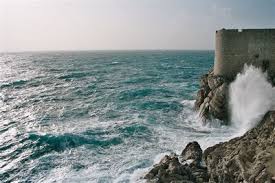George Bernard Shaw was enchanted by this beautiful city: for him, it was paradise. Millions of people also take home happy memories from this "jewel of the Adriatic".
Dubrovnik has a remarkable history. An independent, merchant republic for 700 years (abolished by Napoleon in 1806), it traded with Turkey and India in the East (with a consul in Goa, India) and had trade representatives in Africa (in the Cape Verde Islands). It even had diplomatic relations with the English court in the middle ages. (There is a letter from Elizabeth I on display in the City Museum in Dubrovnik). Its status was such that powerful and rich Venice was envious of this Croatian-Slav city.
The old town was completed in the 13th century and remains virtually unchanged to the present day. Tall ramparts surround it and there are only two entrances to the old town which lead to the Stradun, the city's promenade. One of the greatest pleasures for many visitors is to have a drink in one of the nearby cafes and watch the world go by, whilst they themselves are being watched by the city patron, St. Blaise, or Sveti Vlaho as the locals call him. In 1991/2, the Serbs shelled the city causing considerable damage, but thanks to local efforts and international aid, the old town has been restored to its former beauty.
But whatever we say, our words do not give justice to this dazzling place. So come soon and see it with your own eyes!
You will probably enter the old town through the Pile Gate - in front of you is the Stradun. Here you will find the Onofrio Fountain, built in 1438. On the right is the Franciscan Monastery, with one of the oldest functioning pharmacies in Europe, in operation since 1391. At the other end of the Stradun, you will find the locals' favourite meeting place, the Orlando Column, with the nearby Sponza Place and the baroque church of St. Blaise. Here is also the Rector's Palace, built in 1441, which is now a city museum packed with valuable and historic exhibits.
Opposite the palace through a narrow street is a square, Gunduliceva Poljana, which is the site of the busy morning market. In the same square is the Jesuit Monastery from the early 18th century. From here you can head for the little old town port and visit the city walls, built between the 13th and the 16th centuries, which encircle the city and which have been remarkably preserved.
If you are visiting in the summer, do not miss the world-renowned Dubrovnik Summer Festival, with music, theatre and dance performances. The version of Hamlet on Lovrijenac Tower is magical. The Dubrovnik International Film Festival also runs for several days at the beginning of October.










Dubrovnik has a remarkable history. An independent, merchant republic for 700 years (abolished by Napoleon in 1806), it traded with Turkey and India in the East (with a consul in Goa, India) and had trade representatives in Africa (in the Cape Verde Islands). It even had diplomatic relations with the English court in the middle ages. (There is a letter from Elizabeth I on display in the City Museum in Dubrovnik). Its status was such that powerful and rich Venice was envious of this Croatian-Slav city.
The old town was completed in the 13th century and remains virtually unchanged to the present day. Tall ramparts surround it and there are only two entrances to the old town which lead to the Stradun, the city's promenade. One of the greatest pleasures for many visitors is to have a drink in one of the nearby cafes and watch the world go by, whilst they themselves are being watched by the city patron, St. Blaise, or Sveti Vlaho as the locals call him. In 1991/2, the Serbs shelled the city causing considerable damage, but thanks to local efforts and international aid, the old town has been restored to its former beauty.
But whatever we say, our words do not give justice to this dazzling place. So come soon and see it with your own eyes!
You will probably enter the old town through the Pile Gate - in front of you is the Stradun. Here you will find the Onofrio Fountain, built in 1438. On the right is the Franciscan Monastery, with one of the oldest functioning pharmacies in Europe, in operation since 1391. At the other end of the Stradun, you will find the locals' favourite meeting place, the Orlando Column, with the nearby Sponza Place and the baroque church of St. Blaise. Here is also the Rector's Palace, built in 1441, which is now a city museum packed with valuable and historic exhibits.
Opposite the palace through a narrow street is a square, Gunduliceva Poljana, which is the site of the busy morning market. In the same square is the Jesuit Monastery from the early 18th century. From here you can head for the little old town port and visit the city walls, built between the 13th and the 16th centuries, which encircle the city and which have been remarkably preserved.
If you are visiting in the summer, do not miss the world-renowned Dubrovnik Summer Festival, with music, theatre and dance performances. The version of Hamlet on Lovrijenac Tower is magical. The Dubrovnik International Film Festival also runs for several days at the beginning of October.













 8:58 AM
8:58 AM
 crkota
crkota











 Posted in:
Posted in: 

1 comments:
Greatt blog post
Post a Comment